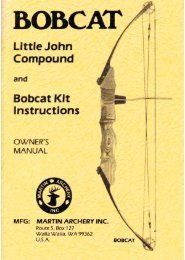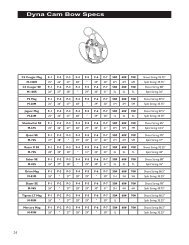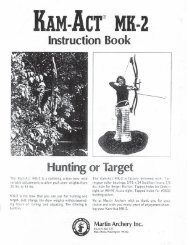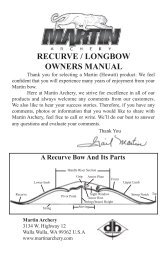fine tuning your compound bow - Martin Archery
fine tuning your compound bow - Martin Archery
fine tuning your compound bow - Martin Archery
You also want an ePaper? Increase the reach of your titles
YUMPU automatically turns print PDFs into web optimized ePapers that Google loves.
SUPERFINE TUNING<br />
SHORT RANGE GROUP TUNING<br />
Short range group <strong>tuning</strong> will work with any style of shooting. Best results are<br />
achieved when this method is used after completing the Bare Shaft Planing or Paper<br />
Tuning tests. This is a good ultra <strong>fine</strong> <strong>tuning</strong> method when space will not permit long<br />
range shooting. After completing the following steps you will have very clean arrow<br />
flight and a well tuned, accurate setup.<br />
To begin the short range <strong>tuning</strong> method, you will need a piece of cardboard, or a<br />
target face will do nicely. Make a broad line through the center of the paper on the<br />
blank side, making sure the line is thick enough to see from twenty yards. Start at<br />
about 10 to 15 yards from the target. Use <strong>your</strong> <strong>tuning</strong> target and position the line<br />
vertically when you are <strong>tuning</strong> the arrow rest and position the line horizontally when<br />
you are <strong>tuning</strong> the nock point.<br />
This pattern<br />
shows a<br />
vertical<br />
disturbance.<br />
This pattern<br />
shows a clean<br />
vertical<br />
pattern.<br />
Vertical Impact<br />
Position <strong>your</strong> line horizontally and shoot six arrows at the line. Concentrate on<br />
keeping <strong>your</strong> pin on the line. Don’t worry about left and right hits, just try to keep <strong>your</strong><br />
shots on the line. Shoot two good groups, discarding any rough or bad shots, and note<br />
the vertical impact of the arrows and their relationship to the line. All adjustments are<br />
made with the nock point during these steps.<br />
If <strong>your</strong> arrows are not consistently grouping on the line, make small 1/32"<br />
adjustments up or down with the nock point and shoot two more groups. Continue<br />
making nock adjustments in small increments. If all of <strong>your</strong> arrows begin to hit on the<br />
line you are correcting the nock position. In the event that <strong>your</strong> groups widen, move<br />
<strong>your</strong> nock back to its original location and make small adjustments in the opposite<br />
direction.<br />
This pattern<br />
shows a<br />
horizontal<br />
disturbance.<br />
This pattern<br />
shows a clean<br />
horizontal<br />
pattern.<br />
Horizontal Impact<br />
After achieving a nice, straight, horizontal pattern, rotate <strong>your</strong> target so <strong>your</strong> line<br />
will appear vertical. Just as before, shoot two good groups, discarding any rough or<br />
bad shots, and note the horizontal impact of the arrows and their relationship to the<br />
line. All adjustments are made with the arrow rest during these steps.<br />
If <strong>your</strong> arrows are not consistently grouping on the line, make small 1/32"<br />
adjustments left or right with the arrow rest and shoot two more groups. Continue<br />
making rest adjustments in small increments. If all of <strong>your</strong> arrows begin to hit on the<br />
line you are correcting the rest position. In the event that <strong>your</strong> groups widen move <strong>your</strong><br />
rest back to its original location and make small adjustments in the opposite direction.<br />
18
















